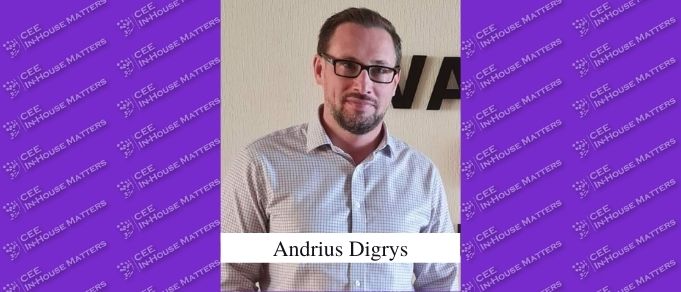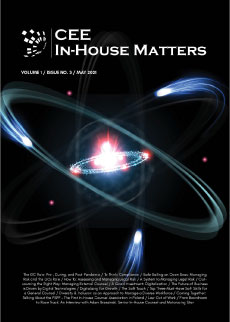On May 21, 2021, CEE Legal Matters reported that Ellex Valiunas had successfully represented Western Baltija Shipbuilding in its appeal of a public procurement award to a consortium of Finnish companies to provide a specialized vessel for the Lithuanian Armed Forces to eliminate pollution incidents and carry out rescue operations in the Baltic Sea. CEE In-House Matters spoke with Andrius Digrys, General Legal Counsel at Western Baltija Shipbuilding, to learn more about the deal.
CEEIHM: Tell us a bit about Western Baltija Shipbuilding.
Andrius: WBS is a subsidiary of the Western Shipyard Group (WSY). WSY is a part of the biggest Estonian corporation – BLRT Grupp.
The Western Shipyard Group is one of the largest marine engineering corporations in Lithuania for already five decades. Currently, the group incorporates 21 companies that specialize in different fields of activity and provides all services related to the life cycle of a ship. The main activities of the group are shipbuilding, ship repair and conversion, complex ship design and engineering solutions, large and complex metal construction and equipment production, stevedoring services.
The Western Shipyard Group is the largest employer in Western Lithuania, creating over 3,000 jobs.
Western Baltija Shipbuilding specifically is a modern shipyard offering a full range of services from conceptual design to "turn-key" projects. The main direction of Western Baltija Shipbuilding strategy is building steel blocks, hulls, and "turn-key" vessels.
The shipyard was founded on January 19, 1947. The first product: a non-propelled barge was built by 1952. Every year we register a growing production of different types of ships, mainly fishing trawlers. During the 70 years of operations, it has built over 350 ships. The shipyard has also built floating docks which have been exported around the world. Some of them are still in operation.
The next significant step in the shipyard’s development took place on April 19, 1997. The shipyard was acquired by Odense Steel Shipyard LTD (OSS) which was a part of the Danish A.P. Moller-Maersk group. During this period the shipyard started to invest in modern technologies. It registered an absolute record – it produced more than 50,000 tones of different steel blocks and ship hulls per year.
In 2010 the shipyard was acquired by BLRT Grupp. For 10 years now, Western Baltija Shipbuilding has maintained its leading position in shipbuilding in the Baltics region.
CEEIHM: Ellex Valiunas successfully helped you challenge a public procurement award. What is the background of the case?
Andrius: Ellex Valiunas was responsible for legal support. All arguments – two of which were accepted by the court as valid and relevant – were elaborated by the WBS team led by myself.
WBS participated in the public procurement tender organized by Lithuanian Armed Forces (LAF). The object of the tender was a search and rescue vessel, which also had to fulfill towing, oil/pollution-fighting, divers support, and other functions. The budget of the tender was more than EUR 39 million.
In November 2020, LAF awarded the contract to a third-party shipbuilding yard leaving WBS in second place. After a comprehensive examination of the competitor’s offer, the WBS team found at least 4 examples of non-compliance with the tender’s documentation. In other words, the competitor offered a vessel, which in the opinion of WBS, does not comply with the tender documentation requirements. These 4 examples were the arguments (factual ground) for challenging the award. In December 2020, pre-court claims of WBS were rejected by the LAF. Therefore WBS took the decision to commence legal proceedings just before the very end of 2020.
CEEIHM: What were the main arguments supporting your claim?
Andrius: WBS elaborated the following four arguments (grounds) to support our claim. Two of these arguments were accepted by the court, which proves that the competitor’s offer did not comply with the tender requirements:
- The functionality of the vessel. The competitor’s offer did not include a possibility to have all needed functions onboard the vessel all the time (or without significant interference to the operation of the vessel). The vessel could perform only one or a few functions and to perform the remaining ones, re-installation of respective equipment had to be carried out (for example the vessel could not perform the collection of oil/pollution and perform towing operations in that set-up). For a re-installation, the vessel either had to be brought back to the port facilities or another floating unit had to be used. Assessing this argument, the court came to the conclusion that the tender’s requirements related to functionality have to be properly interpreted at first. The court accepted this argument and maintained that the tender documents definitely require the vessel to be fully functional without any significant interference to the vessel’s operation. Further, the court concluded that LAF and the competitor did not prove that the competitor’s offer complies with the tender’s requirements.
- Material of the vessel’s superstructure. In the opinion of WBS, the tender’s documentation established a requirement that the vessel’s superstructure has to be constructed using steel. The competitor’s offer foresaw that the superstructure will be constructed partially from steel and partially from aluminum. Unfortunately, this argument was rejected by the court.
- The possibility to remove machinery and/or components from the engine room without cutting the vessel. The competitor’s offer did not include a possibility to remove machinery and/or components from the engine room without cutting/damaging the vessel. This conclusion was made based on the General Arrangement Plan (GA Plan) submitted by the competitor. The court accepted this argument and concluded that this argument was not denied by LAF and the competitor.
- Unusually long (240 months) warranty period for the main components of the vessel. In the opinion of WBS, the competitor’s offer establishing a 240 month additional warranty period for the main components of the vessel was (i) unusual in terms of industry practice and (ii) economically unreasonable. Unfortunately, this argument was rejected by the court.
CEEIHM: What's next, following the court’s decision?
Andrius: The court judgment came into effect on May 12, 2021. The judgment inter alia withdrew interim measures (suspension of the tender) and from this date, the tender should continue. Unfortunately, LAF has not continued the tender – ignoring the judgment and WBS’s notices for resumption of the tender. Just recently, on June 14, 2021, we became aware that LAF submitted an appeal in cassation. That was the last date for an appeal in cassation. According to Lithuanian law, cassation proceedings are handled by the Supreme Court of Lithuania (SCL). The SCL is free to choose whether to accept an appeal in cassation or to refuse it.
CEEIHM: Why did you choose Ellex Valiunas as your legal counsel for the matter?
Andrius: We, as a group of companies, and myself personally have a long and successful cooperation with Ellex Valiunas in arbitration and litigation cases as well as various legal matters related to public law fields. It was quite easy for us to choose Ellex Valiunas for this public procurement dispute – as I have my personal experience with the key persons, who took part in these proceedings. In other words – I trust the Ellex Valiunas team even in very extensive and complex matters.


